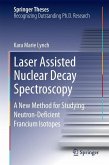Alpha decay is a type of radioactive decay in which an atomic nucleus emits an alpha particle, and thereby transforms (or 'decays') into an atom with a mass number 4 less and atomic number 2 less. An alpha particle is the same as a helium-4 nucleus, and both mass number and atomic number are the same. Alpha decay is by far the most common form of cluster decay where the parent atom ejects a defined daughter collection of nucleons, leaving another defined product behind (in nuclear fission, a number of different pairs of daughters of approximately equal size are formed). Alpha decay is the most likely cluster decay because of the combined extremely high binding energy and relatively small mass of the helium-4 product nucleus (the alpha particle). Alpha decay, like other cluster decays, is fundamentally a quantum tunneling process. Unlike beta decay, alpha decay is governed by the interplay between the nuclear force and the electromagnetic force







